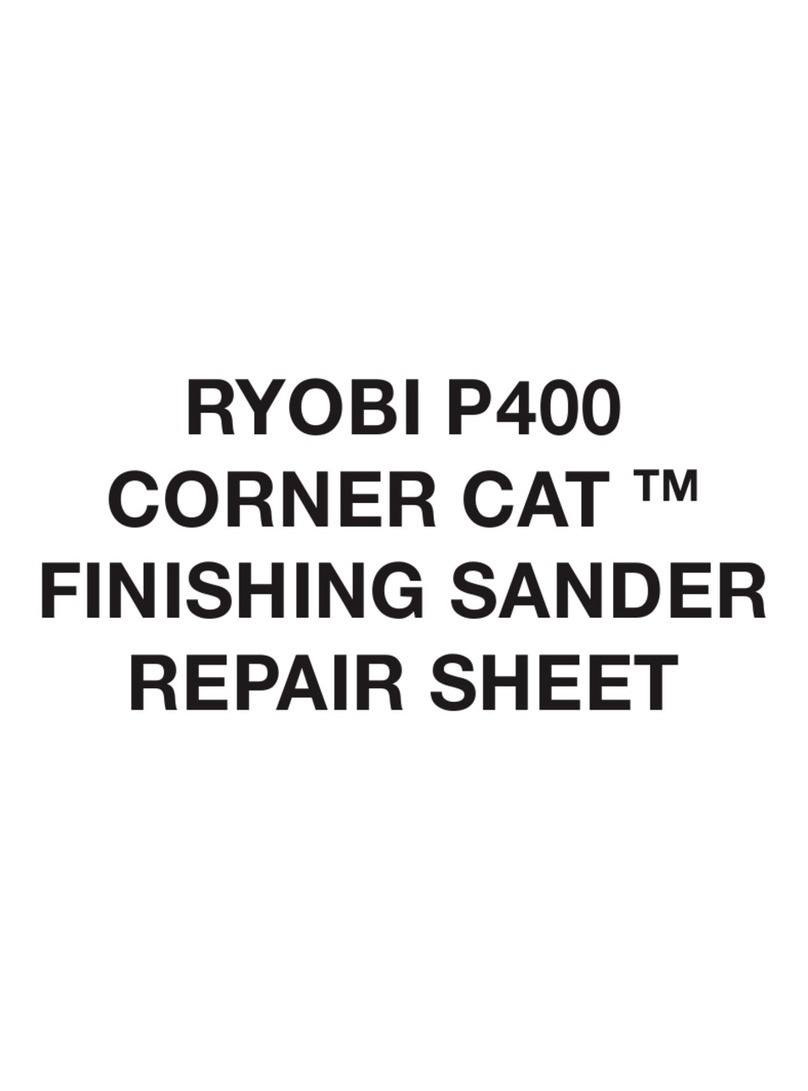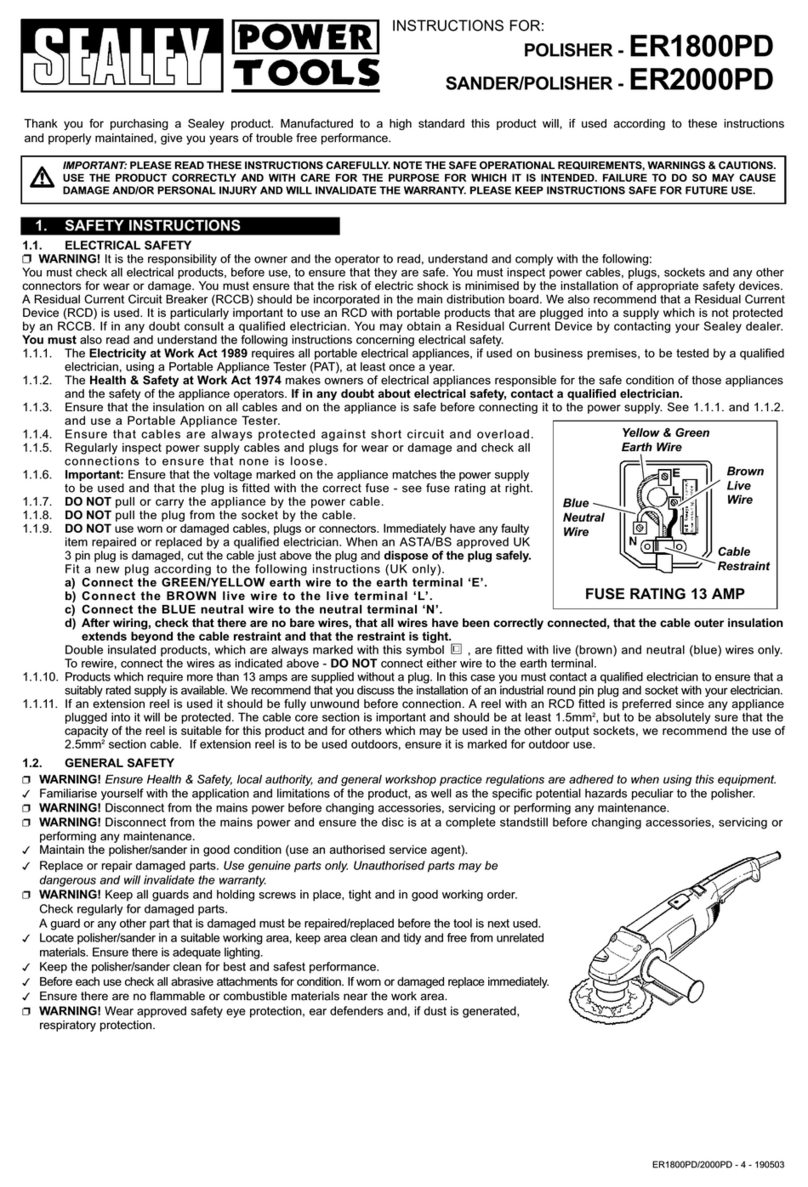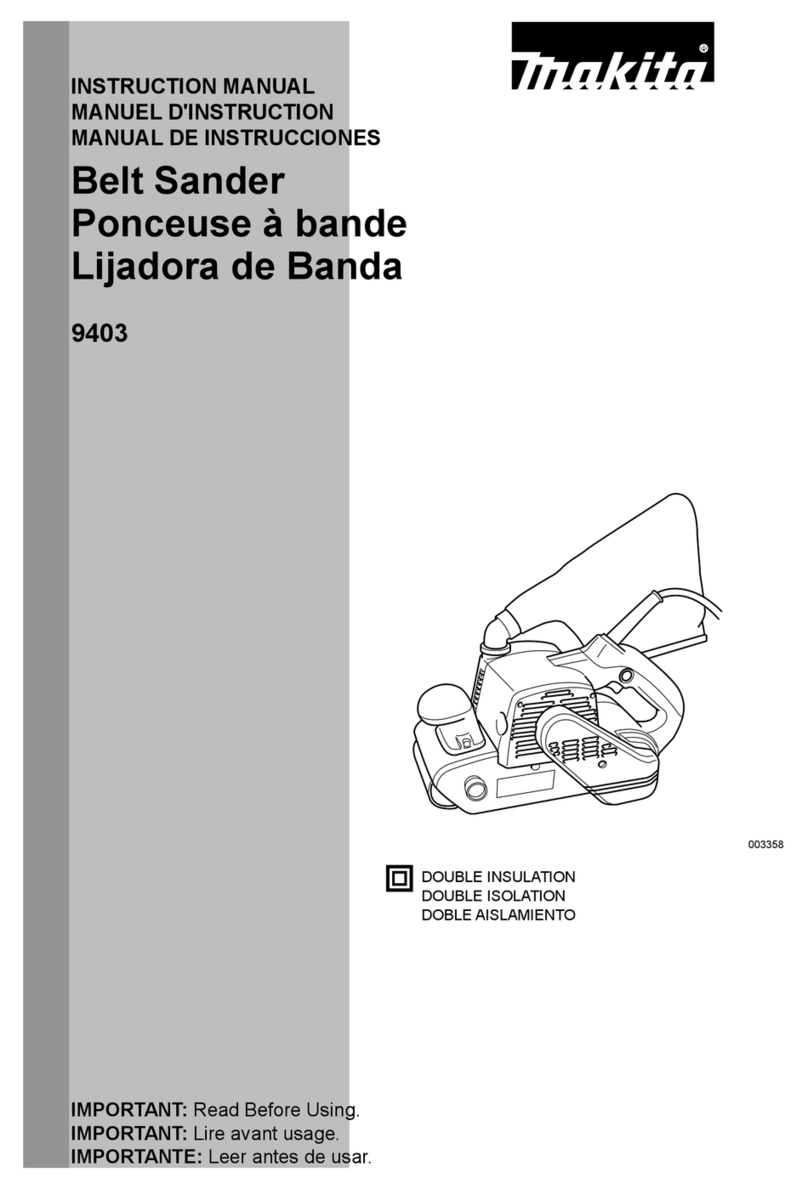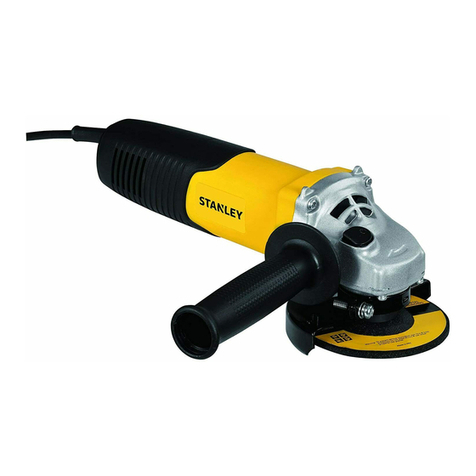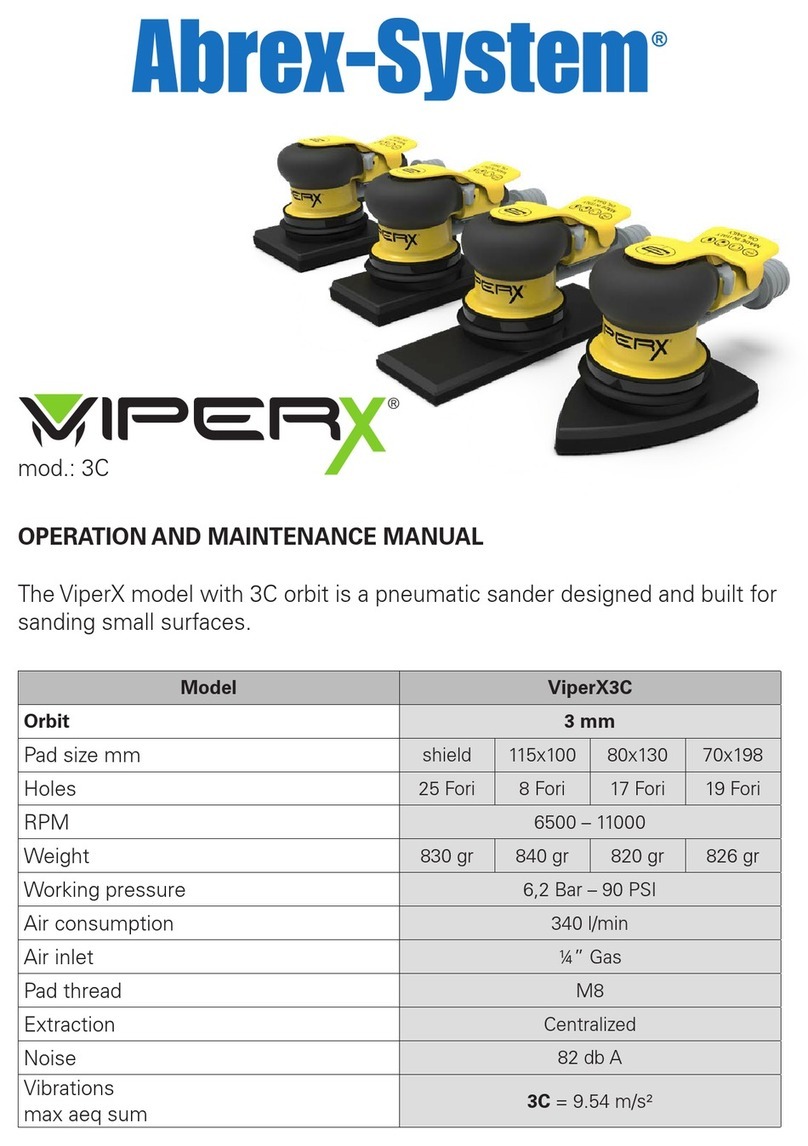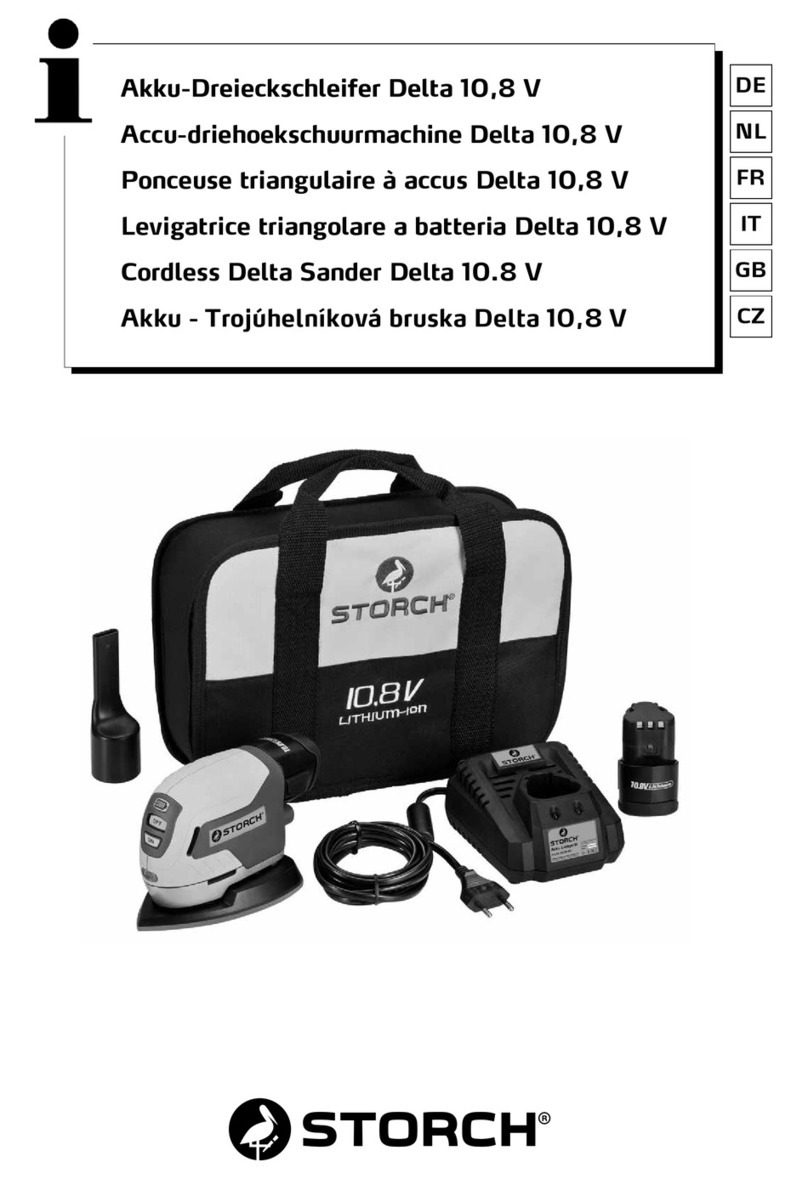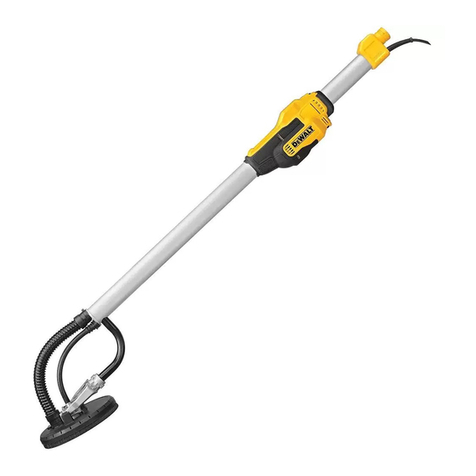BLACKCUBE XW-1203 User manual

12V CORDLESS POLISHER
Model: XW-1203

Dear customer,
Thank you for your purchasing of BLACKCUBE product in Toolplaza store.
In order to ensure the safe transportation of products,
we have been continuously optimizing packaging and striving to provide you
with the best products.
If the product you received is damaged or has quality problems.
Please contact us through Email below and attach product pictures of related
problems, we will reply to you as soon as possible, and provide you with
the best solution.
Email: [email protected]
Looking forward to your next purchase and wish you a happy life!
Best wishes
Toolplaza

Introduction
Congratulations on the purchase of your new appliance. You have selected a
high-quality product.The operating instructions are part of this product.They
contain important information about safety,usage and disposal. Before using
the product, please familiarise yourself with all operating and safety
instructions. Use the product only as described and for the range of
applications specified. Please also pass these operating instructions on to any
future owner.
Symbols used
The following symbols and key words are used in this operating manual, on the
drill or on the packaging.
WARNING!
Indicates a hazard that, if not avoided, could result in death or serious injury.
CAUTION!
Signals a hazard that can cause injuries when ignored.
Intended purpose
The device is suitable for polishing or sanding paints, plastics, coatings and
other smooth surfaces. Any other use that is not explicitly approved in these
instructions may result in damage to the equipment and represent a serious
danger to the user. The user or operator is responsible for accidents causing
injury to other people or damage to property. This equipment is not suitable for
commercial use. Commercial use will invalidate t
01
e guarantee.
read the instructions
Protection category 2
Use ear protection.
Wear mask.
Do not discard electrical appliances with household waste.

02
NO
Technical Data
TE
The vibration level specified in these instructions has been measured in
accordance with the standardized measuring procedure specified and can be
used to make equipment comparisons. The specified vibration emission value
can also be used to make an initial exposure estimate.
WARNING!
The vibration level varies in accordance with the use of the power tool and
may be higher than the value specified in these instructions in some cases.
Regular use of the electric tool in such a way may cause the user to
underestimate the vibration. Try to keep the vibration loads as low as possible.
Measures to reduce the vibration load are, e.g. wearing gloves and limiting the
working time. Wherein all states of operation must be included (e.g. times
when the power tool is switched off and times where the power tool is switched
on but running without load).
Rated voltage 12 V DC
Battery type Li-Ion
Capacity 2000 mAh
Charge time ca.
(hours) 4 - 6 h
Input voltage 100 - 240 V ~
Frequency 50/60 Hz
Input current 0,4 A
Output voltage 13,5 V DC
Output current 0,5 A
Protection class II
Rated voltage: 12 V (DC)
Rated idle speed: 2500–5000 rpm
Polisher pad size: Ø150mm
Tool
Battery charger
Battery

03
WARNING! Read all safety warnings designated by the
symbol and all instructions.
General Power Tool Safety Warnings
WARNING! Read all safety warnings, instructions, illustrations and
specifications provided with this power tool. Failure to follow all
instructions listed below may result in electric shock, fire and/or serious injury.
Save all warnings and instructions for future reference.
The term "power tool" in the warnings refers to your mains-operated (corded)
power tool or
battery-operated (cordless) power tool.
1) Work area safety
a) Keep work area clean and well lit. Cluttered or dark areas invite accidents.
b) Do not operate power tools in explosive atmospheres, such as in the
presence of
flammable liquids, gases or dust. Power tools create sparks which may
ignite the dust or fumes.
c) Keep children and bystanders away while operating a power tool.
Distractions can
cause you to lose control.
2) Electrical safety
a) Power tool plugs must match the outlet. Never modify the plug in any
way. Do not use any adapter plugs with earthed (grounded) power tools.
Unmodified plugs and matching outlets will reduce risk of electric shock.
b) Avoid body contact with earthed or grounded surfaces, such as pipes,
radiators,
ranges and refrigerators. There is an increased risk of electric shock if your
body is earthed or grounded.
c) Do not expose power tools to rain or wet conditions. Water entering a
power tool
will increase the risk of electric shock.
d) Do not abuse the cord. Never use the cord for carrying, pulling or
unplugging the
power tool. Keep cord away from heat, oil, sharp edges or moving parts.
Damaged or entangled cords increase the risk of electric shock.
e) When operating a power tool outdoors, use an extension cord suitable
for outdoor use. Use of a cord suitable for outdoor use reduces the risk of
electric shock.
f) If operating a power tool in a damp location is unavoidable, use a
residual current device (RCD) protected supply. Use of an RCD reduces
the risk of electric shock.
NOTE The term “residual current device (RCD)” can be replaced by the term

04
“ground fault circuit interrupter (GFCI)” or “earth leakage circuit breaker
(ELCB)”.
3) Personal safety
a) Stay alert, watch what you are doing and use common sense when
operating a power tool. Do not use a power tool while you are tired or
under the influence of drugs, alcohol or medication. A moment of
inattention while operating power tools may result in serious personal injury.
b) Use personal protective equipment. Always wear eye protection.
Protective equipment such as a dust mask, non-skid safety shoes, hard hat or
hearing protection used for appropriate conditions will reduce personal injuries.
c) Prevent unintentional starting. Ensure the switch is in the off-position
before
connecting to power source and/or battery pack, picking up or carrying
the tool.
Carrying power tools with your finger on the switch or energising power tools
that have the switch on invites accidents.
d) Remove any adjusting key or wrench before turning the power tool on.
A wrench or a key left attachedto a rotating part of the power tool may result in
personal injury.
e) Do not overreach. Keep proper footing and balance at all times. This
enables better
control of the power tool in unexpected situations.
f) Dress properly. Do not wear loose clothing or jewellery. Keep your hair
and clothing away from moving parts. Loose clothes, jewellery or long hair
can be caught in moving parts.
g) If devices are provided for the connection of dust extraction and
collection facilities, ensure these are connected and properly used. Use
of dust collection can reduce dust-related hazards.
h) Do not let familiarity gained from frequent use of tools allow you to
become complacent and ignore tool safety principles. A careless action
can cause severe injury within a fraction of a second.
4) Power tool use and care
a) Do not force the power tool. Use the correct power tool for your
application. The correct power tool will do the job better and safer at the rate
for which it was designed.
b) Do not use the power tool if the switch does not turn it on and off. Any
power tool that cannot be controlled with the switch is dangerous and must be
repaired.
c) Disconnect the plug from the power source and/or remove the battery
pack, if
detachable, from the power tool before making any adjustments,
changing accessories, or storing power tools. Such preventive safety
measures reduce the risk of starting the power tool accidentally.
d) Store idle power tools out of the reach of children and do not allow

05
persons unfamiliar with the power tool or these instructions to operate
the power tool. Power tools are dangerous in the hands of untrained users.
e) Maintain power tools and accessories. Check for misalignment or
binding of moving parts, breakage of parts and any other condition that
may affect the power tool’s operation. If damaged, have the power tool
repaired before use. Many accidents are caused by poorly maintained power
tools.
f) Keep cutting tools sharp and clean. Properly maintained cutting tools with
sharp cutting edges are less likely to bind and are easier to control.
g) Use the power tool, accessories and tool bits etc. in accordance with
these instructions, taking into account the working conditions and the
work to be performed. Use of the power tool for operations different from
those intended could result in a hazardous situation.
h) Keep handles and grasping surfaces dry, clean and free from oil and
grease. Slippery handles and grasping surfaces do not allow for safe handling
and control of the tool in unexpected situations.
5.Battery tool use and care
a) Recharge only with the charger specified by the manufacturer. A
charger that is suitable for one type of battery pack may create a risk of fire
when used with another battery pack.
b) Use power tools only with specifically designated battery packs. Use of
any other battery packs may create a risk of injury and fire.
c) When battery pack is not in use, keep it away from other metal objects,
like paper clips, coins, keys, nails, screws or other small metal objects,
that can make a connection from one terminal to another. Shorting the
battery terminals together may cause burns or a fire.
d) Under abusive conditions, liquid may be ejected from the battery;
avoid contact. If contact accidentally occurs, flush with water. If liquid
contacts eyes, additionally seek medical help. Liquid ejected from the
battery may cause irritation or burns.
e) Do not use a battery pack or tool that is damaged or modified.
Damaged or modified batteries may exhibit unpredictable behaviour resulting
in fire, explosion or risk of injury.
f) Do not expose a battery pack or tool to fire or excessive temperature.
Exposure to fire or temperature above 130 °C may cause explosion.
NOTE The temperature „130 °C”can be replaced by the temperature
„265 °F”.
g) Follow all charging instructions and do not charge the battery pack or
tool outside the temperature range specified in the instructions. Charging
improperly or at temperatures outside the specified range may damage the
battery and increase the risk of fire.
6.Service
a) Have your power tool serviced by a qualified repair person using only
identical replacement parts. This will ensure that the safety of the power tool

06
is maintained.
b) Never service damaged battery packs. Service of battery packs should
only be performed by the manufacturer or authorized service providers.
Joint safety instructions for sandpaper sanding and polishing
a) This power tool is to be used as a sandpaper sander and polisher.
Follow all safety instructions, directives, illustrations and facts which
you receive with the device. If you do not observe the following instructions,
an electrical shock, fire and/or serious injury may occur.
b) This power tool is not suitable for sharpening, wire brushing and
cutting grinding. Using the power tool in ways for which it is not intended may
cause hazards and injuries.
c) Do not use any accessories that are not specifically intended and
recommended for this power tool by the manufacturer. Being able to
attach accessories to the device does not guarantee safe operation.
d) The permissible rotation speed of the attachment tool must be at least
as high as the highest rotation speed indicated on the power tool.
Accessories that run faster than the allowable speed can break and fly apart.
e) The outside diameter and thickness of the attachment tool must
correspond to the dimensions indicated for your power tool. Attachment
tools which are wrongly dimensioned cannot be sufficiently shielded or
controlled.
f) Attachment tools with threaded attachment must fit the threading of
the grinding spindle exactly. For attachment tools which are mounted
through a flange, the diameter of the hole in the attachment tool must fit
the mounting diameter of the flange. Attachment tools which cannot be
precisely attached to the power tool turn unevenly, vibrate very strongly and
can ultimately lead to a loss of control.
g) Do not use any damaged attachment tools. Check attachment tools
such as grinding discs for chipping or cracks, grinding plates for cracks,
wear or strong abrasion and wire brushes for loose or broken wires
before using them. If the power tool or the attachment tool falls off, check
whether it is damaged or use an undamaged attachment tool. If you have
checked the attachment tool and attached it, keep yourself and any
nearby persons out of the plane of the rotating attachment tool and allow
the device to run for 1 min. at the highest rotational speed. Damaged tools
usually break during this test period.
h) Wear personal protective equipment. Depending on the application,
use full face shields, eye protection or safety goggles. In so far as it is
appropriate, wear dust masks, ear protection, gloves or special aprons
which keep small grinding and material particles away from you. Eyes
should be protected from the foreign matter which can be caused to fly during
the various applications. Dust or breathing masks should filter the dust that is

07
created during operation. If you are exposed to loud noise for a long time, you
may suffer hearing loss.
i) Ensure that other people are at a safe distance from your working area.
Anyone who enters the working area must wear personal protective
equipment. Broken bits from the piece being worked or broken attachment
tools can fly away and cause injuries even beyond the direct working area.
j) Only hold the electric tool by the insulated gripping surfaces when
performing work in which the cutting tool may come into contact with
hidden wiring. Contact with a live wire can also cause a charge in metal parts
of the appliance and result in an electric shock.
k) Never put the power tool down before the attachment tool has come to
a full stop. The rotating attachment tool can come into contact with the
surface upon which it is set, whereby you could lose control of the power tool.
l) Never allow the power tool to run whilst you are carrying it. Your clothing
may accidentally come into contact with the rotating attachment tool and get
caught and the attachment tool could drill into your body.
m) Clean the ventilation slits of your power tool regularly. The motor air
pulls dust into the housing and, should too much metallic dust collect, could
cause electrical hazards.
n) Never use the power tool near flammable material. Sparks could ignite
this material.
o) Do not use attachment tools which require liquid coolant. Using water
or another liquid coolant could lead to electrical shock.
Special safety instructions for polishing
a) Do not allow any part of the polisher guard, in particular the fastening straps,
to come loose. Stow away or shorten the fastening straps. Any loose, rotating
fastening strap could catch on your finger or become caught in the Aworkpiece
Special safety instructions for sanding
a) Do not use overly large sandpaper sheets; follow the manufacturer‘s
information for sandpaper sizes. Sandpaper sheets which extend beyond
the sanding plate can cause injuries and can block, tear the sandpaper, or
cause kickback.
Kickback and corresponding safety instructions
Kickback is the sudden reacn frm a hked r bked aachment t such as a
grinding disc, grinding plate, wire brush etc. Hing r blking leads tan abrupt
st f the rtang aachment tl. This causes an uncntred pwer tl t
accelerate in a direcn cunter tthe rtanal direcn f the aachment tl. If,
fr example, a grinding disc cuts intthe wrkpiece r blks it, the edge f the
grinding disc that digs intthe wrkpiece can get caught and, thrugh that, break
the grinding disc r cause a kickback. The grinding disc then mves tards r away
frm the peratr, depending n the direcn f ran f the disc at the blked

08
spt. Here, the grinding discs can alsbreak.
A kickback is caused by wrngly r incrrectly perang the pwer tl. It can be
avded by suitable precaunary measures, such as thse described bew.
a) Firmly hold the power tool and bring your body and your arms into a posion in
which you can resist the kickback forces. Always use the addional handle if
available to give you the best control over kickback forces or reacon toque during
acceleraon. The ratr can master the kickback and reactin frce thrugh
suitable precauns.
b) Never bring your hand near to rotang aachment tools. The aachment tl
can run ver yur hand in the kickback.
c) Keep your body away from the area in which the power tool would
move during a kickback. The kickback drives the power tool in the
counter-direction to the rotation of the grinding disc at the blocked spot.
d) Work particularly cautiously in corner areas or where there are sharp
corners etc. Prevent the attachment tools from recoiling from the
workpiece and jamming. The rotating attachment tool tends to jam when
near corners, sharp edges or when it recoils from such. This causes a loss of
control or kickback.
e) Do not use chain or toothed saw blades. Such attachment tools
frequently cause a kickback or loss of control over the power tool.
Do not use any paints containing lead or materials containing
asbestos.
For battery tools:
1) Instructions regarding battery charging, information regarding ambient
temperature range for tool and battery use and storage, and the
recommended ambient temperature range for the charging system during
charging;
2) For a battery-operated tool intended for use with a detachable battery
pack or a separable battery pack: instructions indicating the appropriate
battery packs for use, such as by a catalog number, series identification or the
equivalent;
3) Instructions indicating the appropriate charger for use, such as by a catalog
number, series identification or the equivalent.
4)For battery tools with integral battery: instruction, how the integral battery
can be removed safely from the tool after the tool’s end of life, and information
about the type of battery such as Li-Ion, NiCd and NiMH.
WARNING!
■Hold the power tool by the insulated gripping surfaces when performing an
operation where the screw or attached tool could come into contact with

09
hidden wiring. Contact between the screw or attached tool and a live wire may
cause exposed metal parts of the power tool to become live and give the
operator an electric shock.
Safety guidelines for battery chargers
This appliance may be used by children aged 8 years and above and by
persons with limited physical, sensory or mental capabilities or lack of
experience and knowledge, provided that they are under supervision or have
been told how to use the appliance safely and are aware of the potential risks.
Children must not play with the appliance. Cleaning and user maintenance
tasks may not be carried out by children unless they are supervised.
The charger is suitable for indoor use only.
WARNING!
To avoid potential risks, damaged mains cables should be replaced by the
manufacturer or the manufacturer’s customer service department or a similarly
qualified person.
Before use
Charging the battery pack
CAUTION!
Always pull out the plug before you remove the battery pack from or connect
the battery pack to the charger.
Never charge the battery pack when the ambient temperature is below 4°C
or above 40°C.
Connect the battery pack to the battery charger.
Insert the power plug into the socket to charge.
When in charging, the LED light below indicates red.
The light turns to green when the battery is fully charged.
The charging time is about 4-6 hours.
Insert the battery pack back into the appliance.

10
Operation
Removing/inserting the Battery
1. To remove the battery from the appliance, press the release button on the
battery and pull out the battery.
2. To insert the battery, place it on the guide track and push it into the
appliance. It will audibly snap in.
Attaching/changing the attachments
The attachments are fastened using a Velcro strip to the polishing disc.
Attaching
1. Place the desired attachment centrally onto the polishing disc.
2. Firmly press the attachment onto the polishing disc.
Removing/changing
1. Pull the attachment sideways from the polishing disc.
XW-120102C XW-120102A1/ XW-120102B1/ XW-120102C1
release button
release button

11
Switching on and off
1. To switch on, tilt the on/off switch to position “I“, the device turns on.
2. To switch off, tilt the on/off switch to position “0“, the device turns off.
3. Firmly hold the device with both hands on the handle.
Setting the rotational speed
♦Adjust the speed setting wheel to a position between 1 and 6.
Checking the battery charge level
♦The battery charge indicator signalizes the state of charge of the battery by
illuminating the corresponding LED lights when the device is in operation. To
see the charge level, keep the on/off switch depressed.
♦GREEN/RED/ORANGE = maximum charge/performance
♦RED/ORANGE = medium charge/performance
♦RED = low charge – charge the battery
on/off switch
battery charge indicator LED
speed setting wheel
polishing disc

12
Working instructions
Securing the workpiece
Fasten and secure the workpiece by means of jigs, a vice or with another
method on a stable surface. If you hold the workpiece only with your hand, foot
or against your own body, it will stay instable and this can lead to a loss of
control.
Touching up
For touch-up work, choose the sandpaper.
If required, polish the workpiece being machined after the touch-up.
Polishing
• Please refer to the information from the polishing agent manufacturer.
• Test the polishing pads, imitation fur and polishing agent prior to use on an
inconspicuous area.
• Use the orange polishing pad for pre-polishing, the black polishing pad for
post-polishing, and the imitation fur for high-gloss polishing and to remove
excess polishing agent.
• Put some polishing agent onto the polishing pad. Put polishing agent onto an
area slightly smaller than the area you wish to polish on the workpiece and
spread the polishing agent manually.
• Move the device evenly over the surface to be polished.
• Do not apply any pressure. Pressing onto the workpiece does not improve
the work result.
• Do not allow the polishing agent to dry. Therefore, do not work in direct
sunlight or on a heated surface. There is a risk of surface damage!
Maintenance and cleaning
WARNING! RISK OF INJURY! Always switch the appliance off and
remove the battery before carrying out any work on the appliance.
The cordless drill is maintenance-free.
■The appliance must always be kept clean, dry and free from oil or grease.
■Never allow liquids to get into the appliance.
■Use a soft, dry cloth to clean the housing. Never use petrol, solvents or
cleansers which can damage plastic.
■If a lithium-ion battery is to be stored for an extended period, the charge level
should be checked regularly. The optimum charge level is between 50% and
80%. The optimum storage environment is cool and dry.
NOTE
►Replacement parts not listed (such as batteries, switches) can be ordered
via our service hotline.
Table of contents
Popular Sander manuals by other brands
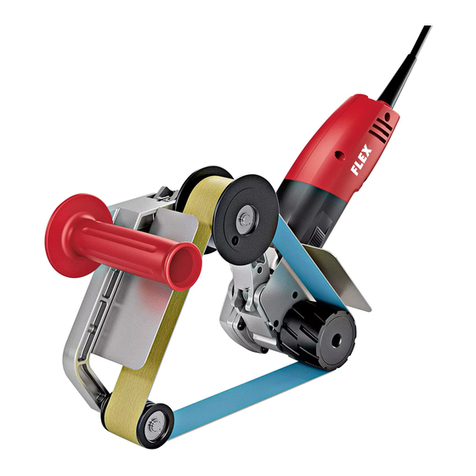
Flex
Flex BME 14-3 L operating instructions

Clarke
Clarke American Sanders EZ-8 CE Operator's manual
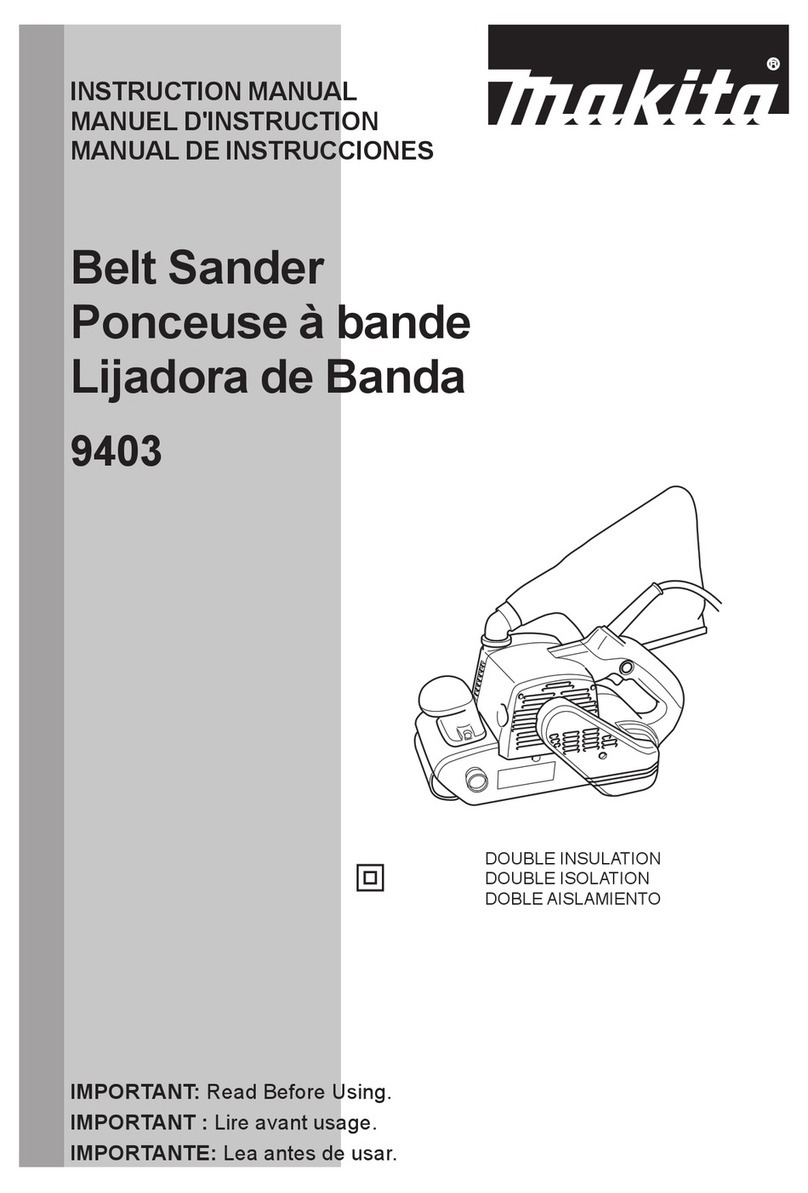
Makita
Makita 9403 instruction manual

Jet
Jet SandSmart 22-44 Pro Operating and parts manual
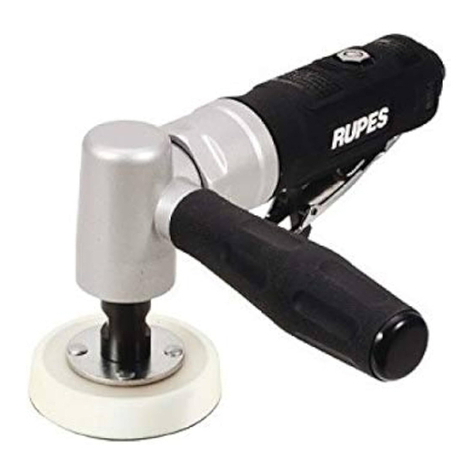
Rupes
Rupes LH75P Operating and maintenance instructions

Black & Decker
Black & Decker KA900E-XE Original instructions

